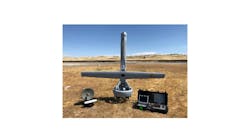Four companies to provide prototype small UAVs to determine how they work with future Army helicopter fleet
ABERDEEN PROVING GROUND, Md. – U.S. Army aviation expert are asking four unmanned aircraft designers to provide prototypes to determine how well unmanned aerial vehicles (UAVs) will work with the Army's military helicopter fleet of the future.
Officials of the Army Contracting Command at Aberdeen Proving Ground, Md., announced a potential $99.5 million contract Thursday for the Future Tactical Unmanned Aerial Systems (FTUAS) program.
Four UAV companies -- Textron AAI Corp. in Hunt Valley, Md.; Arcturus UAV in Rohnert Park, Calif.; Martin UAV in Plano, Texas; and L3Harris in Ashburn, Va. -- will share the $99.5 million three-year contract, and will compete for separate orders over the three-year duration of the contract.
The Army will buy as many as two commercial off-the-shelf (COTS) Group 2/3 UAVs from each company, as well as spare parts, logistics, training, and maintenance. Army experts will demonstrate these UAVs at various Army bases over the course of the contract.
The idea is to determine how well these UAVs work with Army brigade combat teams, as well as with the Army Future Vertical Lift project to define the next generation Army helicopter fleet.
AAI, Arcturus, Martin, and L3Harris will provide Group 2/3 UAVs, optical payloads, ground control stations, ground data terminals, ground support equipment, special tools, and spare parts.
Group 2 UAV family weighs between 21 and 55 pounds, flies at altitudes lower than 3,500 feet at speeds slower than 250 knots. Examples include the Boeing Insitu ScanEagle, and the Aerovel Flexrotor. Group 3 UAVs weigh less than 1,320 pounds and fly at altitudes lower than 18,000 feet, and at speeds slower than 250 knots. Examples are the AAI RQ-7 Shadow, the Boeing Insitu RQ-21 Blackjack, and Arcturus JUMP 20 and T-20.
AAI makes the Aerosonde, Shadow, and Nightwarden UAVs. The Shadow V2 weighs 375 pounds, and flies at altitudes to 18,000 feet at speeds to 126 knots. The Nightwarden weighs 750 pounds and can reach altitudes of 20,000 feet. The Aerosonde weighs 28.9 pounds and flies at altitudes of 15,000 feet at speeds to 45 miles per hour.
The Arcturus JUMP 20 UAV weighs 185 pounds and flies at altitudes to 25,000 feet at speeds to 86 miles per hour. The Martin UAV V-BAT UAV can take off vertically and is designed for shipboard operations. It weighs 82 pounds, and can reach altitudes of 15,000 feet at speeds from zero to 90 knots.
The L3Harris (formerly Latitude Engineering) FVR UAV is a vertical-takeoff aircraft that weighs 117 pounds and flies at altitudes to 5,000 feet at speeds to 65 knots.
On this contract the four contractors will do the work at locations to be determined with each order, and should be finished by July 2019.
For more information contact Textron AAI online at www.textronsystems.com; Arcturus UAV at https://arcturus-uav.com; Martin UAV at https://martinuav.com, or L3Harris at www2.l3t.com/latitudeengineering.
About the Author
John Keller
Editor-in-Chief
John Keller is the Editor-in-Chief, Military & Aerospace Electronics Magazine--provides extensive coverage and analysis of enabling electronics and optoelectronic technologies in military, space and commercial aviation applications. John has been a member of the Military & Aerospace Electronics staff since 1989 and chief editor since 1995.
